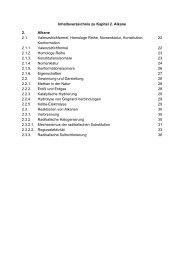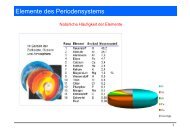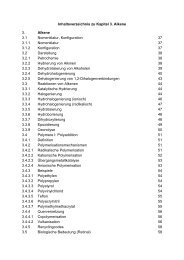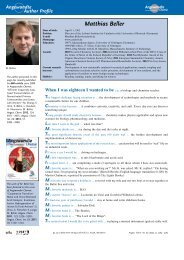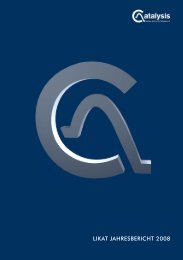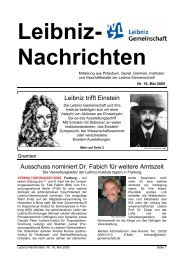Jahresbericht 2007 - Leibniz-Institut für Katalyse
Jahresbericht 2007 - Leibniz-Institut für Katalyse
Jahresbericht 2007 - Leibniz-Institut für Katalyse
Erfolgreiche ePaper selbst erstellen
Machen Sie aus Ihren PDF Publikationen ein blätterbares Flipbook mit unserer einzigartigen Google optimierten e-Paper Software.
Magnetische Resonanz- und Röntgenmethoden Magnetische Resonanz- und Röntgenmethoden<br />
Themenleiterin:<br />
Priv.-Doz. Dr. Angelika<br />
Brückner<br />
Tel.: (030) 6392 – 4301<br />
Fax: (030) 6392 – 4454<br />
angelika.brueckner<br />
@catalysis.de<br />
operando-Druck-EPR<br />
Kooperationspartner:<br />
Dr. D- Maschmeyer,<br />
Oxeno Olefinchemie<br />
GmbH<br />
Operando-high pressure-EPR:<br />
A new tool for monitoring catalytic<br />
reactions under industry-like<br />
conditions demonstrated for olefin<br />
oligomerization over Ni catalysts<br />
Introduction and Objectives<br />
Supported NiO catalysts are used since many years for the<br />
heterogeneous catalytic oligomerization of low olefins. In the case of<br />
butenes, there are two possible reaction pathways: 1) isomerization<br />
to undesired strongly branched products over acidic support sites<br />
dominating in the initial reaction period and 2) oligomerization<br />
to linear C -C olefins over Ni sites becoming prevalent during<br />
8 12<br />
equilibration of the catalysts [1]. Despite extensive research in the<br />
field, the behaviour of Ni sites during equilibration and their nature<br />
in the active state is still controversially discussed, considering both<br />
single Ni + or Ni2+ as well as Ni0 species as being active. From ex-situ<br />
EPR and FMR studies, we obtained hints that the equilibration process<br />
might be governed by a dynamic segregation and redissolution of<br />
Ni0 particles [1]. However, for deriving reliable structure-function<br />
relationships, spectroscopic studies under true reaction conditions<br />
are inevitable. In this work, we have adapted EPR spectroscopy for<br />
monitoring the behaviour of Ni sites in different catalysts during<br />
oligomerization of butenes (Raffinat III). To the best of our knowledge,<br />
this is currently the only example of operando-high pressure EPR in<br />
catalytic liquid/solid systems.<br />
Results and Discussion<br />
A thick-wall tubular quartz reactor has been directly implemented<br />
in the cavity of a Bruker ELEXSYS 500-10/12 cw-EPR spectrometer<br />
and connected to a liquiflow meter and a pressure controller for<br />
maintaining a pressure of 20 bar and to a GC for online product<br />
analysis (Fig. 1). Two different types of catalysts have been monitored<br />
under Raffinat III flow at 80 °C: an industrial NiO/SiO -Al O catalyst<br />
2 2 3<br />
(NiO) and various 0.3 - 6 % Ni/SiO -Al O prepared by impregnation<br />
2 2 3<br />
with an organic Ni complex (0.3Ni – 6Ni). In NiO, the dissolution of<br />
initially formed ferromagnetic Ni0 clusters was detected just with the<br />
onset of catalytic activity. It was supposed that this process is related<br />
to oxidative addition of Brønsted sites, Ni0 + H + → Ni + –H, but the<br />
related Ni + species could not be detected due to superposition with<br />
the intense Ni0 line. However, the typical rhombic EPR signal of Ni +<br />
has been found together with ferromag-netic Ni0 in catalysts 0.3Ni –<br />
6Ni. In 6Ni, formation of the latter was completed after 90 min time<br />
on stream while the catalyst started to become active only after 300<br />
min. This shows without any doubt, that ferromagnetic Ni0 clusters<br />
are not active (Fig. 1).<br />
Conclusions<br />
For the first time, oligomerization of butenes (Raffinat III) has been<br />
followed over supported Ni-containing catalysts by EPR under true<br />
reaction conditions (20 bar, 80 °C). Initially formed ferromagnetic<br />
Ni0 clusters revealed to be not active and are partially dissolved<br />
during equilibration, most probably by reaction with H + to form<br />
Ni + sites regarded as active ones. The experimental setup can be<br />
eas-ily adapted to other reactions working with catalysts containing<br />
paramagnetic transition metal species.<br />
Literatur<br />
[1] P. Albers, U. Bentrup, A. Brückner, F. Nierlich, H.-W. Zanthoff, D.<br />
Maschmeyer, DGMK-Tagungsbericht 2004-3, ISBN 3-936418-23-3.<br />
Operando-EPR of 6% Ni/<br />
SiO -Al O under 20 bar<br />
2 2 3<br />
Raffinate III at 80 °C:<br />
Ni0 cluster formation<br />
completed within first<br />
90 min (top) but activity<br />
starts only after 300 min<br />
(bottom)<br />
→ Ni0 particles not active<br />
54 55




